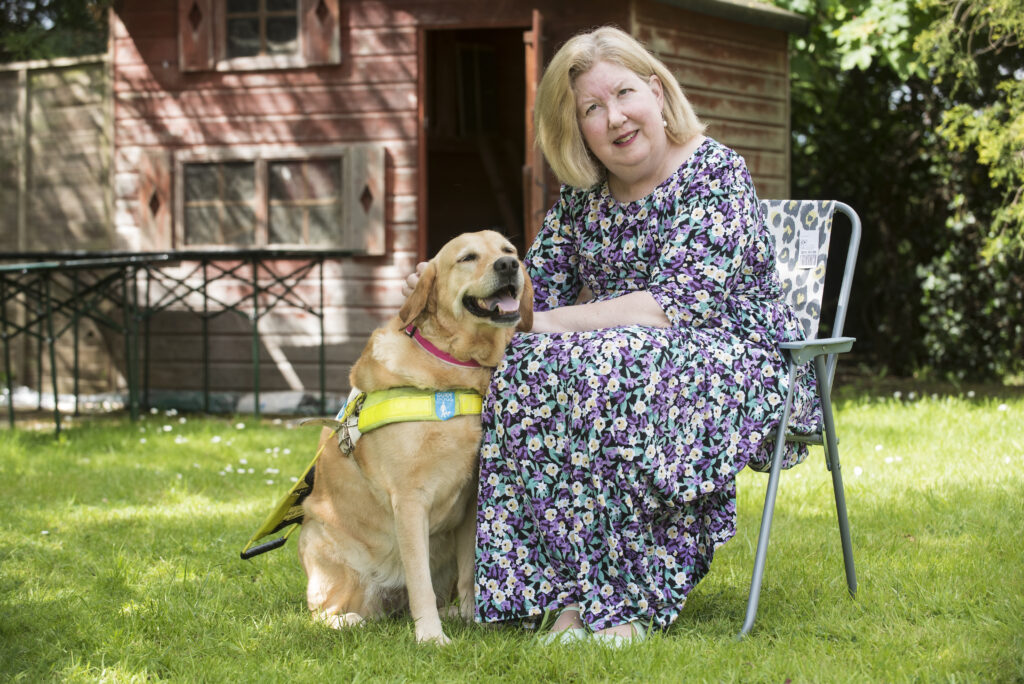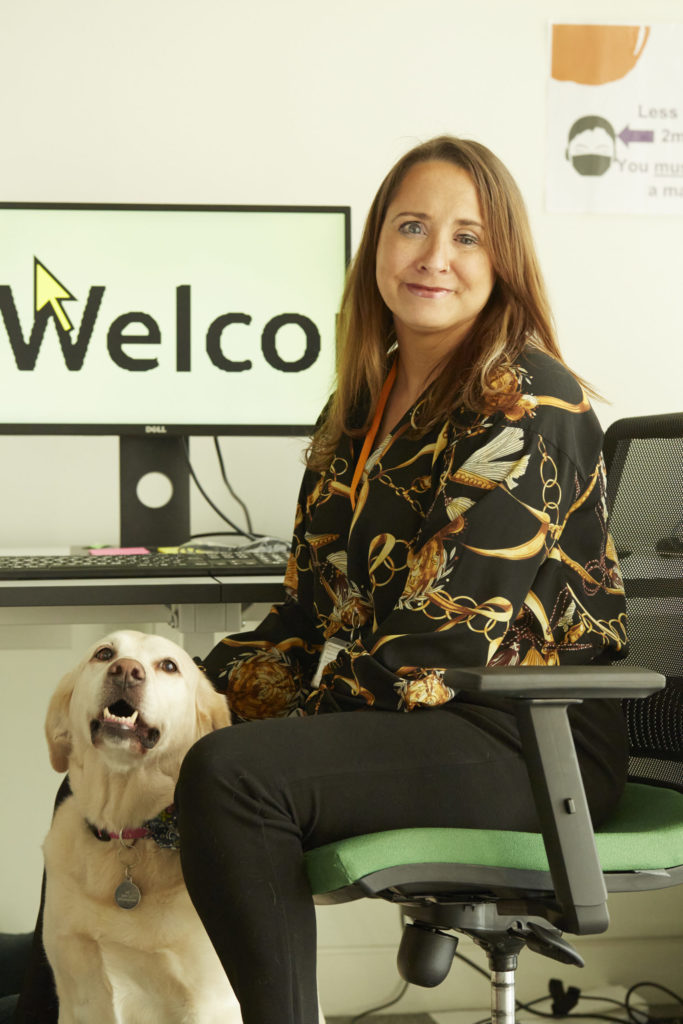Guide dogs and assistance dogs
Some people use highly trained dogs to support them with day-to-day tasks.
Guide dogs and assistance dogs can support people with visual impairments, autism, epilepsy and more.

Looking for support?
We offer support for disabled people all over the UK. To find out what kind of support we could give you or your loved one, speak to one of our friendly team.
Find out more about what types of assistance dogs you can get in the UK, what they do and how to apply for a guide dog.
On this page:
- What are assistance dogs?
- Types of assistance dog
- What are guide dogs?
- What do guide dogs do?
- How many guide dogs are there in the UK?
- How to get a guide dog
- Travelling with an assistance dog
- What the Equality Act 2010 says about assistance dogs
- Can I pet a guide dog?
What are assistance dogs?
Assistance dogs are dogs that are trained to support people with disabilities and mental health conditions.
You’ve probably heard of guide dogs, who are trained to support people with visual impairments. Guide dogs help with navigation and other day-to-day activities.
Other kinds of support dogs are available for people with autism, epilepsy and a range of other conditions or disabilities.
You can usually spot an assistance dog by the harness or jacket they’re wearing. It may be hi-vis, and some will be labelled “support dog” or “assistance dog”.
These dogs are very highly trained, and will usually be quietly sitting or walking alongside their owner.
Types of assistance dog
There are lots of types of assistance dogs and guide dogs in the UK.
Assistance Dogs UK is a coalition of organisations that supply assistance dogs to people all around the country for different purposes.
We’ve listed some of the most common assistance dogs here, but visit Assistance Dogs UK to find out more about the many types of support dogs available.
Guide dogs for blind people
Guide dogs for the blind and visually impaired are the most well-known type of assistance dog.
The first guide dogs were trained in Merseyside, in the north of England, back in 1931. The idea was to support servicemen who had lost their sight.
Today, trained guide dogs are an invaluable support to many different people with visual impairments.
Find out more about guide dogs.
Hearing dogs for D/deaf people
Hearing dogs can alert owners with hearing loss to important sounds like the doorbell or alarms.
They can even be trained to alert their owners to a crying baby.
Find out more about hearing dogs.
Assistance dogs for autism
Autism assistance dogs can support autistic children and adults in various different ways.
As well as being beloved companions, they can help to manage anxiety, support with daily tasks and respond to emergency situations.
The specific actions your dog can perform will depend on the dog and how it is trained.
An autism support dog might:
- Offer helpful sensory input when an autistic person is feeling overwhelmed (for example, providing deep pressure by lying on the person).
- Fetch helpful objects, like favourite stim toys.
- Interrupt attempts to self-harm.
Find out more about autism assistance dogs.
Assistance dogs for epilepsy
Some assistance dogs are trained to support people with epilepsy. They can raise the alarm when someone is about to have a seizure.
By alerting their owners to a seizure up to 50 minutes beforehand, epilepsy support dogs give them the opportunity to go to a safe, quiet place.
Find out more about epilepsy seizure alert dogs.
Support dogs for mental health
There are assistance dogs who are trained to support people with anxiety and other mental health conditions.
Assistance dogs help carry out day-to-day tasks, like fetching items, and can raise the alarm in an emergency.
Remember, assistance dogs are not the same as emotional support dogs, who offer general support through companionship.
Emotional support dogs are:
- Not trained to the same standard as assistance dogs.
- Not protected by law. (Find out more about what the law says about assistance dogs.)
What are guide dogs?

Guide dogs are dogs who are specially trained to support people with visual impairments.
They are usually golden retrievers or labradors, or a mix of the two breeds. Sometimes, guide dogs are German Shepherds, or other breeds.
This is because these breeds were historically working dogs, and so respond very well to being trained.
What do guide dogs do?
Guide dogs act like a kind of mobility aid for their owners. They can help visually impaired people to avoid obstacles and to successfully navigate through busy or cluttered areas.
Guide dogs are trained to:
- Walk in the middle of the pavement or walkway, avoiding obstacles.
- Stop when they come to kerbs, doors or steps.
- Follow their owner’s instructions on which direction to go.
Guide dogs help people with sight impairments to get around without hitting obstacles, and to cross roads safely. But they still depend on their owners to direct them on where to go.
How many guide dogs are there in the UK?
In 2022, the charity Guide Dogs reported that it was supporting around 4,452 new and existing guide dog partnerships.
Assistance Dogs UK states that there are over 7,000 assistance dogs (including guide dogs) currently in the UK.
How to get a guide dog
If you have a visual impairment, you may be wondering if a guide dog could support you.
On this page, you can find a brief summary of how to apply for a guide dog.
Find out everything you need to know about the process of getting a guide dog from Guide Dogs.
Applying for a guide dog
If you want to apply for a guide dog, you must meet Guide Dogs’ eligibility criteria. Once you apply, they will carry out two assessments to check that you are a good fit for a guide dog.
This includes a mobility assessment, and a guide dog assessment.
The assessors will check for various factors, including:
- That your visual impairment has a significant impact on your ability to move around.
- That you, and your household, are able to provide a safe home for a dog.
- That you are mobile and active enough to take care of a young guide dog.
How much does a guide dog cost?
Guide Dogs are able to offer fully trained guide dogs to people who need them at no cost.
How long does it take to get a guide dog?
The wait for a guide dog will vary depending on lots of different factors.
Guide dogs are bred, raised and trained over a period of several years. When you apply for one, the length of time you have to wait to be matched with a dog will depend on factors like:
- The guide dogs that are ready and available.
- The length of the waiting list of people in need of a guide dog in your area.
- Your specific needs.
Travelling with an assistance dog
It is your right to travel and use public transport in the UK with your assistance dog. (If you are travelling internationally, it’s important to also check the regulations of the place you’re visiting.)
This is supported by the Equality Act 2010 in England, Scotland and Wales, and the Disability Discrimination Act 1995 in Northern Ireland.
It’s a good idea to carry your Assistance Dogs UK ID Book with you when travelling or using public transport. This book should have been given to you by the member organisation that supplied your assistance dog.
Get more information about travelling with a guide dog from Guide Dogs.
What the Equality Act 2010 says about assistance dogs
Under the Equality Act 2010, it is unlawful to refuse access to someone because of their assistance dog. This effectively means that guide dogs and assistance dogs can go anywhere that you go.
There are some rare exceptions to this rule – for example, some hospital wards.
However, in general, the Equality Act 2010 states that:
- It is illegal to discriminate against somebody because they are disabled. This means that it would be illegal to refuse you entry, for example to a shop, because of your assistance dog.
- It is a legal requirement for businesses to make reasonable accommodations for disabled people. This means that business owners should, for example, make exceptions to their “no dogs” policy for assistance dog owners.
- It is also illegal to harass or victimise someone because they are disabled.
Some businesses might need you to prove that your assistance dog is an assistance dog. For this reason it’s a good idea to carry your Assistance Dog ID UK Book.
For more information, read this guide to assistance dogs for businesses, from the Equality and Human Rights Commission.
Can I pet a guide dog?
Guide dogs and assistance dogs may look cute, like any other dogs, but you should not distract them from their work by petting them.
They are working dogs with an important job to do. Distracting them could be inconvenient or even potentially dangerous for their owner.
If you really want to say hello, it is important to always ask the dog’s owner first.
Ask us how we can support you
If you or a loved one have complex disabilities and would like some support, get in touch with our friendly team.
This content was last reviewed in October 2023. We’ll review it again in 2025.
